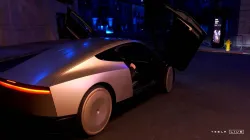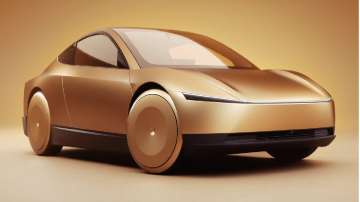Elon Musk unveiled Cybercab robotaxi, Robovan alongside Optimus humanoid robot at Tesla event
At Tesla's 'We, Robot' event, Elon Musk arrived on stage in a Robotaxi Cybercab, a vehicle likely to enter production in 2026. The company is now shifting its focus from being a low-priced mass-market automaker to becoming a robotics manufacturer.

Elon Musk presented a robotaxi with two gull-wing doors and no steering wheel or pedals at an event titled "We, Robot". The event was held at the Warner Bros studio near Los Angeles, California. He also introduced a robovan as Tesla shifts its focus from a low-priced mass-market automaker to a robotics manufacturer. Musk arrived at the event in a "Cybercab" that is expected to go into production in 2026 and be priced at less than USD 30,000 (roughly Rs 25,20,000). He mentioned that the operation would cost 20 cents a mile over time and that charging would be inductive, requiring no plugs.

These cars rely on artificial intelligence and cameras and do not need additional hardware, which Musk believes sets them apart from robotaxi rivals. He emphasised that the autonomous future is here, with 50 fully autonomous cars showcased at the event. Musk also revealed a larger, self-driving vehicle called the Robovan, capable of carrying up to 20 people, and introduced Tesla's Optimus humanoid robot.
Musk's plan is to operate a fleet of self-driving Tesla taxis that passengers can hail through an app. Individual Tesla owners will also be able to make money by listing their vehicles as robotaxis on the app.
It was attended by investors, stock analysts, and Tesla fans. However, some investors left disappointed as they were expecting more concrete details on production ramp-up, regulatory approval, and a strong business plan.
Musk's optimistic time frames have been a point of concern, especially after missed promises in the past. Despite the challenges, Musk is determined to push forward with the development of these vehicles. Unlike other companies in the robotaxi market, Tesla is relying solely on cameras and AI to run its Full Self-Driving (FSD) technology to keep costs down. Musk mentioned the expectation to start fully autonomous unsupervised FSD in Texas and California next year with the Model 3 and Model Y, but did not specify if the robotaxis would use any new technology or depend on FSD.
ALSO READ: How Ratan Tata's vision 'Tata Nano' revolutionised affordable car ownership for common man
Inputs rom Reuters
